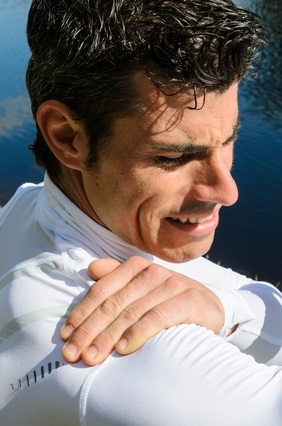 Your shoulder socket is surrounded by tissue called labrum. Sometimes this tissue is damaged or torn – and when this happens, it is called a SLAP tear, which is an abbreviation for “superior labrum anterior to posterior.”
Your shoulder socket is surrounded by tissue called labrum. Sometimes this tissue is damaged or torn – and when this happens, it is called a SLAP tear, which is an abbreviation for “superior labrum anterior to posterior.”
There are many different ways you can get a slap tear. For example, you can get a slap tear while lifting heavy things. You may get a slap tear if you fall on your arm or shoulder. Sometimes people experience a slap tear if they brace themselves during a car accident.
A slap tear is also a common shoulder injury for those who participate in activities that require a lot of throwing or repetitive overhead movements. This includes sports like tennis, baseball, volleyball or swimming. Sometimes football players suffer from a slap tear during a tackle or any intense force to the shoulder and arm.
Diagnosing a Slap Tear
If you think you have a slap tear, you should see a qualified medical professional like Louisville orthopedic surgeon Dr. Stacie Grossfeld for a thorough evaluation. When you experience a slap tear, depending on the severity, it is possible that it may be treated without surgical intervention. In this case a combination of rest, ice, anti-inflammatory medicine like ibuprofen or aspirin, and physical therapy to stabilize and strengthen your shoulder muscles, may be recommended.
If you have a more severe slap tear or if your slap tear is not healing with non-surgical treatment, you may need to have surgery. Your doctor will advise you on whether you need orthopedic surgery for a slap tear based on many different factors.
Slap tears are often classified by severity. The least severe type of slap tear is a Slap 1 lesion. This typically involves degenerative tearing on the inner labrum. The most severe type of slap lesion is a Type 4 slap lesion. This tearing extends from the labrum into the tendon in the bicep. Type II slap tears tend to be one of the most common types of SLAP tears for orthopedic surgeons to repair.
Surgery to Repair a Slap Tear
Surgery for a slap tear generally involves arthroscopy to fix the labrum. Arthroscopic surgery is typically done as an outpatient procedure.
During arthroscopy, your orthopedic surgeon will make small incisions in order to more clearly see your shoulder joint and the damage. Repair for a slap lesion may involve debridement or repair. Debridement is used to fix the uneven edges of a stable tear. This is done if the labrum is still attached to the shoulder socket.
During repair for a slap tear, your surgeon will secure the labrum back to your bone with sutures.
Researchers studying trends in slap repair in the U.S. report that men are three times more likely to have arthroscopy for a slap tear than women. The highest incidence of surgical repair for slap tears nationally is in the 20 to 29 year old and 40 to 49 year old age groups.
Recovery from a Slap Tear
After you suffer from a slap lesion and have your slap lesion repaired, there is a period of time for recovery. During recovery, you may be required to do certain exercises. In the early weeks of recovery, you may be allowed to partake in walking or riding a stationary bike but you will likely not be able to engage in more intense sporting activities that involve jumping or running. You will likely be required to limit overhead sporting activities like swimming for a number of months following slap tear surgery.
Sometimes after surgery for a slap tear, a person’s activity level remains more limited than it was prior to the injury. Researchers led by Provencher and colleagues at the Naval Medical Center in San Diego, California, found that younger people undergoing surgery for a slap tear had better outcomes than those 36 years or older.

Leave a Reply
You must be logged in to post a comment.